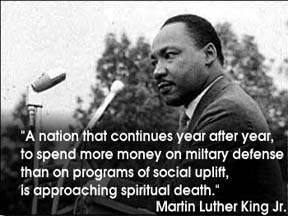DE-CONCENTRATE POVERTY MEANS GETTING RID OF POOR PEOPLE WHILE THEY CONCENTRATE WEALTH IN NEW LUXURY HIGH-RISES
We must de-concentrate poverty. It’s a refrain we are hearing alot from city officials lately, especially now as East of the River communities are facing the first big swells of the massive gentrification wave heading that way from the westside.
Those screaming for the dispersal of poor communities have usually been the developers, more recently the “smart” growthers, and now City officials are parroting it up on their John A. Wilson dais.
“The time has come for us to civilize ourselves by the total, direct and immediate abolition of poverty” — Dr. King, “Where do we go from Here: Chaos or Community”, 1967.
But, instead of seeking tools and policies like a guaranteed basic income, or robust job training programs, feeding programs, good quality schooling, and social uplift, the de-concentration of poverty advocated for by the DC’s developer-class and the City Council and Mayor is that of dispersal, i.e. getting rid of the poor by way of streetcar, condos, hotels, stadiums.
The New Communities program, following on from the Hope VI programs, in turn from Urban Renewal is referenced across many Housing and Urban Development documents as “dispersal projects” no matter what new euphemism they want to call them.
Due to the self-selection inherent in voluntary dispersal programs, and to the screening that these programs apply to applicants, participants are likely to be more motivated and possess more human capital than the families that do not participate. Program operatives choose the families they think will succeed, based on these families’ being organized enough to pass home inspections and other steps in the application process. Still, mobility programs typically have a low success rate, because fewer than half the applicants who are accepted are able to lease an apartment. — The Reality of Deconcentration, By Edward G. Goetz
Simultaneously, while the city disperses the poor to heed the call to de-concentrate poverty, the DC Zoning Commission, Office of Planning, Deputy Mayor’s Office for Planning and Economic Development, alongside Ward level Councilmembers push hard for new projects that have only 8% to 15% “affordable” units in them, and those are usually for singles, not families.
That is, city planners and officials are encouraging, even touting projects that concentrate wealth with 85% of the housing units being built for wealthy single new DC residents.
So, the developer-class wins again with each call from advocate-community and pronouncement by city officials saying we must de-concentrate poverty and rip up generational familial networks with innate powerful neighborhood connections that have grown in some ways to supersede abject poverty through mutual aid and reliance & trust.
The reality is, the development underway in the District is dispersing and displacing poor DC families (the census numbers don’t lie), but consistently concentrating wealthy singles and somehow that is considered good planning in DC.
It’s not, it’s unreasonable and unacceptable. This purposely poor planning has resulted in DC’s #unRealEstateMarket
Deconcentrating poverty is a smokescreen. It camouflages forced relocation of low-income house-holds. What do we mean when we talk about deconcentrating poverty? As it has been implemented to date, deconcentration has meant manipulating the spatial arrangement of federally subsidized low-income families to either disperse or dilute poverty. — The Smokescreen of Poverty Deconcentration, by Edward Goetz
In their own words . . . opinion by Chris Otten, co-facilitator, DC4RD

